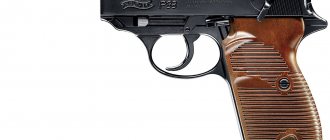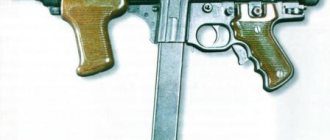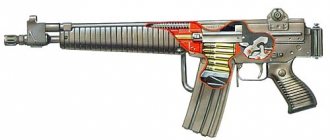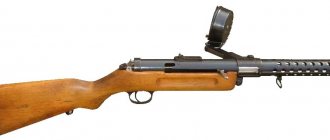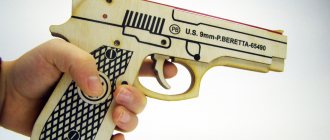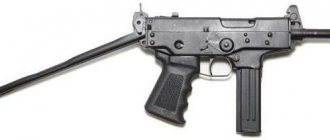Beretta M1938 family submachine guns (Italy)
The Italian Beretta M1918 submachine gun, developed at the very end of the First World War, had a fairly successful design, which allowed it to remain in service until the early forties. In addition, it became the basis for several new modifications of weapons, and also remained in history as one of the first submachine guns in the modern sense of the term. However, despite all the advantages of the M1918, by the mid-thirties the troops needed a new weapon, characterized by a more advanced design and improved characteristics. The response to the new requirements was the Beretta M1938A submachine gun, which turned out to be just as successful as its predecessor. The project for a new weapon did not appear immediately. By the mid-thirties, it became clear that the existing Beretta submachine gun mod. 1918 no longer fully meets modern requirements and must be replaced by newer and more advanced weapons. In order to re-equip the troops, in 1935, Beretta specialists, led by designer Tulio Marengoni, proposed a new project for a submachine gun. It was based on the design of the M1918/30 carbine, but differed from it in some details. This weapon, referred to in some sources as the M1935, did not meet all the requirements, which is why work continued.
The next version of the weapon was proposed in 1938, which affected its name. This submachine gun remained in history under the designations M1938 (“Model 1938”) and MAB 38 – Moschetto Automatico Beretta 38 (“Automatic Beretta Carbine ’38”). These designations are equivalent and can be used in parallel. To designate later modifications, appropriate indices with additional letters are used.
General view of the Beretta M1938 submachine gun. Photo: Wikimedia Commons
When creating new weapons, it was planned to use existing developments. In addition, some innovations were planned. For example, it was proposed to abandon the relatively weak 9x19 mm Glizenti cartridge. This ammunition, which was a modified version of the 9x19 mm Parabellum cartridge, differed from the prototype in its smaller weight of gunpowder and, as a result, in its main characteristics. It was proposed to develop the MAB 38 submachine gun for a new reinforced version of the 9x19 mm Parabellum cartridge. Calculations showed that a slight increase in the powder charge would increase the initial speed of the bullet by about 50 m/s and thereby improve the basic parameters of the weapon.
In 1938, based on the results of design work, the first prototype of a promising weapon was assembled. It is noteworthy that it had some noticeable features that were not carried over to subsequent weapons of the family. Perhaps the most noticeable difference was the barrel design with a muzzle brake-compensator, fullers in the front and an aluminum radiator in the rear. Later it was decided that this barrel design did not meet the existing requirements, which is why the finned radiator was replaced with other cooling means.
Checking the first prototype showed that some of the original solutions implemented in its design did not justify themselves. Based on the test results, T. Marengoni and his colleagues redesigned the weapon’s automation, and also changed the design of the barrel and its cooling systems. The result of these alterations was an increase in the reliability of the mechanisms and a noticeable reduction in the cost of the finished weapon. The updated submachine gun did not receive its own designation, retaining the M1938 index. In this form and under this name, the weapon subsequently went into production. It should be noted that in some sources this weapon is referred to as M1938A, however, there is information about the use of this name in relation to another development of the family.
Being a further development of the M1918 submachine gun, the new Beretta M1938 had a similar design and assembly of units. The main element of the weapon was the receiver, made in the form of a hollow tube with rectangular lower compartments under the front and rear parts. The front rectangular part served as the magazine shaft, the rear part served as the casing of the trigger mechanism. A barrel was threaded to the front of the receiver, to which was attached a tubular casing with perforations. The back of the box was closed with a round lid. The assembled receiver with installed trigger parts was fixed on a wooden stock, which was a modified unit of an existing weapon of the M1918/30 type.
Beretta M1918 submachine gun. Photo: Forgottenweapons.com
The promising weapon was equipped with a 9 mm rifled barrel with a length of 315 mm (35 calibers). The barrel was fixed in the receiver and protected from the outside by a perforated casing. It was proposed to screw a brake-compensator with four transverse slots in the upper part to the muzzle. Due to the correct redistribution of the flow of powder gases, this device was supposed to reduce barrel toss during shooting. On the barrel casing, in the front lower part, there were devices for attaching a bayonet-knife.
Like its predecessor, the new submachine gun was supposed to use blowback-based automation. The main part of such automation was a complex-shaped shutter. Its rear part had the shape of a cylinder, and a deep recess was provided on the lower front part. In addition, inside the bolt there were several cavities for installing various internal parts, including the firing pin. An interesting feature of the Beretta M1938 bolt was the absence of its own cocking handle. This device was made as a separate part.
The cocking handle was located in a special recess on the right surface of the receiver and was an L-shaped (when viewed from above) part. When moving backward, the handle interacted with the bolt and cocked it, after which it freely moved forward. In its forward position, the handle covered the side slot of the receiver with a long curtain bar and prevented dirt from getting inside the weapon. It is noteworthy that the use of such protection against contamination led to a redesign of the cartridge ejection system.
A characteristic feature of the M1918 and M1938 submachine guns was the use of a relatively small diameter recoil spring. Since in this case the spring could not have sufficient bending rigidity, it was placed inside a tubular casing and a corresponding hole in the bolt. For greater rigidity, a metal rod was included in the spring on the bolt side. The casing was made in the form of a glass with a washer at the bottom, designed to rest against the rear cover of the receiver.
The first prototype of the MAB 38. The barrel with fins and without a casing is clearly visible. Photo Opoccuu.ru
The Beretta MAB 38 submachine gun received a hammer-type firing mechanism. Inside the bolt, in its front part, there was a movable firing pin. The middle part housed the trigger and some other parts. Their task was to ignite the cartridge primer after the bolt moved to the forward position. Due to the use of a reinforced cartridge, special requirements were placed on the automatic weapon regarding the correct sequence of work.
While working on the project of a new weapon, T. Marengoni used a fairly old idea, which was abandoned two decades ago. He proposed not to equip the submachine gun with a fire translator. Instead, two separate triggers should have been used: the front one should have been responsible for single-shot fire, the rear one for automatic fire. The triggers had different shapes at the top, which is why they interacted differently with other trigger parts. A fuse was also provided. It was made in the form of a swinging flag on the left surface of the receiver. He had to move along a shallow recess in the stock. According to some reports, the safety blocked only the rear trigger and allowed single fire.
The new submachine gun was supposed to use reinforced 9x19 mm Parabellum cartridges, placed in detachable box magazines. The M1938 product could use double-row magazines with a capacity of 10, 20, 30 or 40 rounds. It was proposed to place the magazine in the lower receiving window in the stock, covered with a metal cover with a movable shutter. To avoid contamination of the weapon, the window should be closed after removing the magazine. Using its own spring, the magazine fed the cartridges to the chambering line, where they were picked up by the bolt. After firing, the bolt removed the spent cartridge case and threw it out through a window in the upper left part of the receiver. Due to the presence of a movable bolt handle with its own shutter, a different arrangement of extraction mechanisms was not possible.
The Beretta MAB 38 submachine gun received a wooden stock with a pistol lug, inside of which there were cavities for installing all the necessary mechanisms. The overall assembly of the weapon was carried out using pins and screws. In addition, the rear part of the barrel casing was additionally attached to the stock using a clamp, which provided a front swivel. The rear one was made in the form of a recess on the left surface of the butt with a metal axis.
Complete disassembly of the M1938. The receiver is cut due to legal requirements. Photo Sportsmansguide.com
The weapon received open sights. A small front sight was placed on the barrel casing, in front of the muzzle brake-compensator. In the middle part of the receiver (behind the window for ejecting cartridges) there was an open sight with the ability to adjust for shooting at different distances.
The total length of the M1938 submachine gun was 946 mm, weight without cartridges was 4.2 kg. Thus, the new weapon was shorter than its predecessor, but differed from it in greater weight. However, other characteristics, including increased firepower, gave the newer weapons a distinct advantage over the older ones.
Automation based on a free shutter and a reinforced pistol cartridge made it possible to fire at a rate of up to 600 rounds per minute. Shooting was carried out from an open bolt. The fire mode was selected using different triggers, which to a certain extent made the shooter’s work easier and faster. A reinforced cartridge with an increased amount of gunpowder, according to various sources, accelerated a 9-mm bullet to an initial speed of about 430-450 m/s. Due to this, the effective fire range reached 200-250 m.
In 1938, she manufactured and tested prototypes of a new submachine gun, which opened the way for this weapon into the army. In addition, the development of the design continued. Late that year, a design known as the M1938A was introduced, tailored to the Army's wishes. It differed from the basic weapon in the design of an efficient brake-compensator and the absence of mounts for a bayonet. Otherwise the M1938A/MAB 38A was similar to the basic M1938/MAB 38.
German paratroopers with Italian M1938 submachine guns. Photo Opoccuu.ru
A promising submachine gun was developed for arming the army and law enforcement agencies. Their representatives got acquainted with the new weapons, after which the first contracts appeared. The starting customer for the MAB 38 in the first version (with the old compensator brake and bayonet mounts) was the colonial police Polizia dell'Africa Italiana, which worked in Africa. Several thousand new submachine guns were ordered to arm the colonial police.
Later, contracts were signed for the supply of M1938A submachine guns for the army, carabinieri and other structures. According to reports, various special forces were the first to receive new weapons. Subsequently, based on available capabilities, the command distributed new weapons among other units. Due to the impossibility of producing the required number of weapons, until 1942-43, the Beretta MAB 38 systems were available only to tankers, Blackshirts, carabinieri, paratroopers and some other structures. Despite their low distribution, such weapons showed good results and earned good reviews.
Over time, some units operating submachine guns designed by T. Marengoni began to receive special vests for transporting stores. On the chest part of such a vest there were five horizontal oblong pockets for magazines with 40 rounds of ammunition. Access to the magazine was through the right flap with a clasp. Due to its resemblance to traditional Japanese combat equipment, this vest received the nickname “samurai”.
Airborne units used standard submachine guns, although a special version of the weapon was developed for them. The submachine gun with the symbol Modello 1, developed in 1941, received a pistol grip and a folding metal butt instead of a stock. To make it easier to hold the weapon, the magazine shaft was lengthened. This modification did not go into production, but the original ideas of this project were later used in new developments.
An Italian soldier with an M1938 submachine gun and a samurai vest with magazines. Photo: Wikimedia Commons
The main reason for insufficient production volumes was the relatively high cost of weapons. For this reason, the M1938/42 project was developed in 1942, the purpose of which was to simplify the design of the weapon and reduce the cost of its production. During this modernization, the submachine gun lost its barrel casing and magazine window cover. The sight was left without the ability to change the firing range, the stock in front was shortened to the magazine window, and the barrel received several longitudinal valleys and became shorter. Finally, the requirements for the quality of manufacturing parts were reduced, which also affected the complexity and cost of production.
The M1938/42 submachine gun with a 213 mm barrel (23.6 caliber) had a total length of 800 mm and weighed only 3.27 kg. The automation and firing mechanism remained the same, but the maximum rate of fire dropped to 550 rounds per minute. Two separate triggers survive.
The MAB 38/42 product became the basis for two new types of weapons. The first to appear was the M1938/43 submachine gun, which differed from the 1942 model only in the absence of fullers on the barrel, which led to some simplification of production. The subsequent M1938/44 had more serious differences.
In the M1938/44 project, the rear part of the bolt was redesigned and a new return spring was used. Instead of a small-diameter spring, it was proposed to use a larger part that does not require additional casings and is simply placed inside the receiver. Despite such modifications, the characteristics and dimensions of the weapon remained at the same level. At the same time, production costs have decreased significantly. According to some reports, submachine guns mod. 1943 and 1944 were produced with both a wooden stock and a metal butt.
Submachine gun MAB 38/43 in the version with a folding stock. Photo Miles.forumcommunity.net
It should be noted that all submachine guns up to and including the MAB 38/43 model were produced before the surrender of the Kingdom of Italy. The production of the M1938/44 sample was already established by the Italian Social Republic. There is reason to believe that the use of new improvements was the result of a reduction in production capacity associated with the offensive of the anti-Hitler coalition.
The MAB 38 family submachine guns of the first models were produced in relatively small quantities, which is why they were not widely used. The situation changed only in 1942. This led to the beginning of the supply of such weapons to a large number of units of the Italian army. In addition, mass production contributed to the rearmament of the Italian, Yugoslav and Albanian resistance, which successfully used captured submachine guns.
Several export contracts were signed. According to available data, in 1941, Romania ordered Italy 5 thousand submachine guns in the MAB 38 version. These weapons were produced and delivered to the customer early next year. Soon after this, a contract appeared with Japan for the supply of 350 weapons. Before the capitulation in September 1943, Italian gunsmiths managed to send only 50 submachine guns to the customer.
Some Italian weapons were supplied to Nazi Germany. Products arr. 1942 and 1943 were adopted under the designation Machinenpistole 738 (I) or MP 738. The newer MAB 38/44 operated under the designation MP 737.
Beretta M1938/44 cutaway. Picture Berettaweb.com
After the end of World War II, the Beretta M1938 family of submachine guns remained in service with several armies, primarily the Italian one. This weapon worked well during the war, and its quick replacement was not possible. In addition, the replacement was soon considered unnecessary, and in 1949 a new modification of the weapon was developed.
The M1938/49 submachine gun was a "refined" version of the M1938/44 with improved production quality and some design changes. The end of hostilities allowed the manufacturer not to skimp on the production of weapons, which had a corresponding impact on serial submachine guns. Instead of a safety box, this weapon had a safety in the form of a transverse button located above the triggers. When this part was shifted to one side, the trigger was blocked, and the opposite position allowed firing. In the mid-fifties, the MAB 38/49 product was renamed Beretta Model 4. The weapon was exported under this name.
In 1951, the MAB 38/49 became the basis for the MAB 38/51 or Model 2 airborne submachine gun. Such a weapon lost its wooden stock, instead of which relatively short side plates, a pistol grip and a folding stock were installed. A long magazine tube similar to that used on the '41 Mod 1 was also used. In 1955, the Model 2 became the basis for the Model 3, a weapon with a retractable stock and an automatic safety on the handle.
The main customer of the Beretta M1938 family of submachine guns was the Italian armed forces and security forces. During World War II, a number of such weapons were ordered by the Axis countries, and some of the produced samples were captured by partisans. After the war, Italy began mass production of updated weapons for its own needs and for export. A significant number of weapons of new modifications of the MAB 38 were sold to countries in Latin America and Asia. In addition, Germany, which operated these submachine guns until the early sixties, became a major customer.
American soldier with a Beretta Model 1938/49 submachine gun. Photo Militaryfactory.com
Production of later modifications of the Beretta M1938 submachine gun continued until 1961. After this, the assembly of such weapons was discontinued due to the emergence of a newer and more advanced model. Beretta has mastered the production of the new Model 12 submachine gun, which soon began to enter the army and police. The operation of the existing weapons continued over the next few years, but was later discontinued due to replacement with new models. By the second half of the sixties, Italy completely abandoned the old and outdated MAB 38 of all modifications.
The Beretta M1938/MAB 38 submachine gun project is of great interest due to its long and unusual history. This weapon was created in the late thirties, and then was actively used by the army and was repeatedly modernized in connection with its new needs. After the end of World War II, the family's submachine guns were not melted down due to obsolescence. On the contrary, their production and further development continued. The latest modifications of the family were created in the mid-fifties - 16-18 years after the development of the basic model. The operation of weapons, in turn, continued until the mid-sixties. Not many submachine guns created before or during World War II can boast such a long history of use.
Based on materials from: https://world.guns.ru/ https://forgottenweapons.com/ https://opoccuu.com/ https://militaryfactory.com/ Popenker M.R., Milchev M.N. World War II: the gunsmiths' war. – M.: Yauza, Eksmo, 2008
Specifications [edit]
The MAB 38 in its early incarnations was a fine weapon by any standard, made from high quality materials, immaculately finished and with carefully crafted parts. Models 38/42 and 38/44 were easier and faster to build, finishing was sacrificed for speed of production, but quality remained high. The mechanism was the traditional simple blowback-recoil mechanism, but with a new floating striker, automatic safety when the bolt was open (both were later removed to save production costs), a recoil compensator at the muzzle, a cocking handle with a sliding dust cover, and a hammerless trigger mechanism. fire switch, but with two triggers instead; the front trigger was for semi-automatic fire, and the rear trigger was for full-automatic fire. The user could quickly switch between methods without switching levers or safeties, which proved useful in combat. The fully automatic trigger had a safety on the left side, which was eliminated from 1942, and the rear sight was adjustable to 500 m (550 yd) in the MAB 38 and 38A, the 38/42 and 38/44 variants had a fixed rear sight. The MAB 38 had a wooden stock, was about 800 mm (31 in) long and weighed about 5 kg (11 lb) loaded, with an effective range of about 200 m (220 yd).
Links[edit]
- ^ ab "Guns for Freedom". The Daily Star
. December 29, 2022. Retrieved August 31, 2022. - ^ B Abbot, Peter (February 2014). Modern African Wars: Congo 1960–2002
. Oxford: Osprey Publishing. paragraph 44. ISBN 978-1782000761. - JWH1975 (27 September 2015). "StG-44 in Africa after the Great Patriotic War". WII after WII
. WordPress. Retrieved April 3, 2022. - ^ ab Small Arms of the World, page 488
- ^ B s d e g Iannamico, Frank (June 1998). "Moschetto Automatico Beretta 38/42". Small Arms Review
. Vol. 1 PC. 9. - Jump up
↑ Dunlap, Roy F., Ordnance Went Up Front, Samworth Press, (1948), p. 58 - ^ ab Miller, David. Fighters of World War II, Volume I: Axis Powers - Uniforms, Equipment and Weapons (Fighters of World War II)
. Stackpole Books. pp. 139, 353. ISBN 0-8117-0277-4. - Quarrie, Bruce, Fallschirmjäger: The German Paratrooper, 1935-45
, Osprey Publishing (2001), ISBN 1-84176-326-8, ISBN 978-1-84176-326-2, p. 59 - Ordnance Leads the Way, page 58: “No one ever worried about any other kind of submachine gun if he could get his hands on a Beretta M38 and keep it. New Zealand boys especially loved them. Even the Germans liked it and didn't want to admit that something was good. except for your things."
- ↑
Lexikon der Wehrmacht Maschinenpistolen (in German) - ^ ab Artillery came forward, page 58
- ^ abc Hogg, Ian W. and Weeks, John, 20th Century Military Small Arms
, 6th ed. DBI Books, Inc. (1991), pp. 224-225. - ↑
Smith, Joseph E.,
Small Arms of the World
, 11th ed., Harrisburg, PA: The Stackpole Company (1969), pp. 481-482 - ^ abcdefghij Small Arms of the World, pp. 482-483
- Small Arms of the World, page 429
- "Moschetto Automatico Beretta". Historiamilitaria.it
(in Italian). Marco Marzilli. Retrieved September 8, 2015. - ^ ab 20th Century Military Small Arms, pp. 224-225
- https://world.guns.ru/smg/it/beretta-m1938-e.html
- https://web.archive.org/web/20020112104153/https://www.nasog.net/datasheets/firearms/smg/Beretta_Model_3.htm
- https://www.youtube.com/watch?v=PtWEBcIP09E&feature=emb_logo
- Windrow, Martin (1997). Algerian War 1954-62
. Men at Arms 312. London: Osprey Publishing. paragraph 37. ISBN 978-1-85532-658-3. - ^ a b c d e Jones, Richard (2009). Jane's Infantry Weapons 2009-2010
. Jane Information Group. pp. 894–905. ISBN 0-7106-2869-2. - ^ abcdef Small Arms of the World, page 487
- "ITALIAN-JAPANESE PISTOL MP 38/43". Dragons of Fire
. Retrieved December 10, 2011. - Small Arms of the World, page 615
- ↑
Thompson, Leroy (March 23, 2022).
Suomi submachine gun
. Weapon 54. Osprey Publishing. paragraph 73. ISBN 9781472819642. - ^B Bishop, Christ (2002). Encyclopedia of World War II Weapons: A Comprehensive Guide to Over 1,500 Weapons Systems, Including Tanks, Small Arms, Combat Aircraft, Artillery, Ships, and Submarines
. Metrobooks. item 262. ISBN. 1-58663-762-2. - https://www.bundesheer.at/truppendienst/ausgaben/artikel.php?id=1437
- Jowett, Philip (2001). Italian Army 1940-45 (3): Italy 1943-45 (Combat) (vol. 3)
. Osprey Publishing. paragraph 17. ISBN 1855328666. - "World Infantry Weapons: Libya". Archived from the original on October 5, 2016.
- JWH1975 (27 September 2015). "StG-44 in Africa after the Great Patriotic War". WII after WII
. WordPress. Retrieved April 3, 2022. - Mark Axworthy Third Axis, Fourth Ally
, page 76 - Small Arms of the World, page 534
- https://www.thefirearmblog.com/blog/2012/08/10/nifty-beretta-model-1938-in-syria/
- Vuksic Velimir (2003). Tito's Partisans 1941-45
. Osprey Publishing. paragraph 60. ISBN 1841766755.
Users[edit]
- Albania: Overrun by Albanian partisans in large numbers during the war.
- Algeria: Used by Armée de Libération Nationale [21]
- Bangladesh: Used by Mukti Bahini. [1]
- Costa Rica: [22] models 38/44 and 38/49 [14] [23]
- Dominican Republic: [22] Model 38/49 [23]
- Cyprus
- Empire of Japan: 350 ordered and 50 delivered in 1943; some were captured by Allied forces in the South Pacific. [24]
- Egypt: models 38/42 and 38/49 [25]
- Ethiopia [22]
- Finland: Italian surplus MP38 purchased in 1958.[26]
- Greece
- Nazi Germany [27]
- West Germany: MP38/49 (model 4) and model 5 designated MP1. Used by the Bundeswehr (until 1959) and Bundesgrenzschutz (replaced in the late 1960s)[5][28]
- Indonesia: MP1938/49 variant. [23] Deployed during the United Nations Operation in the Congo. [2]
- Iran [5]
- Iraq: model 38/44 [14]
- Italy [7] Italian Social Republic [29]
- Italian resistance [5]
- Italian Allied Army
- Syrian National Coalition [34]
